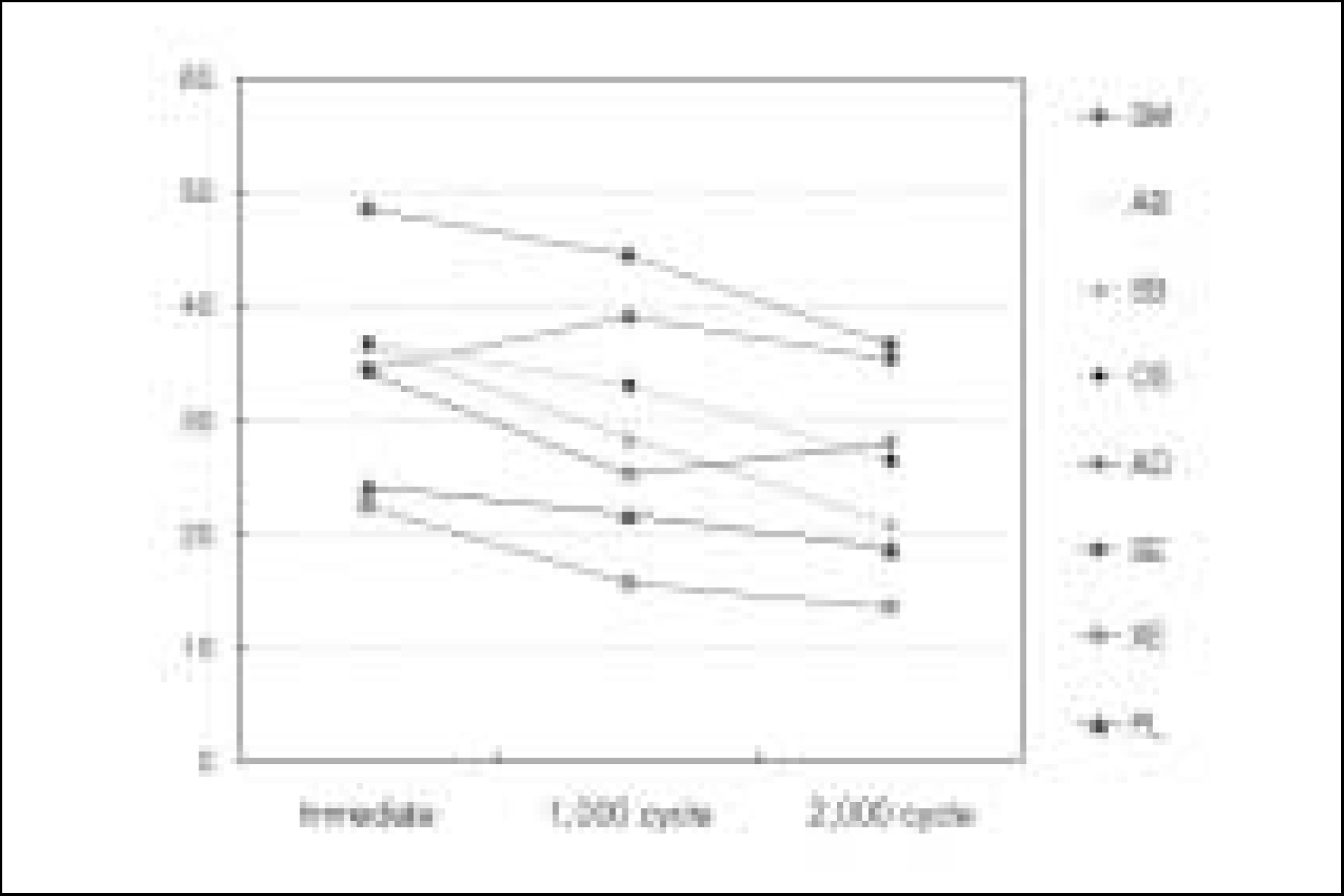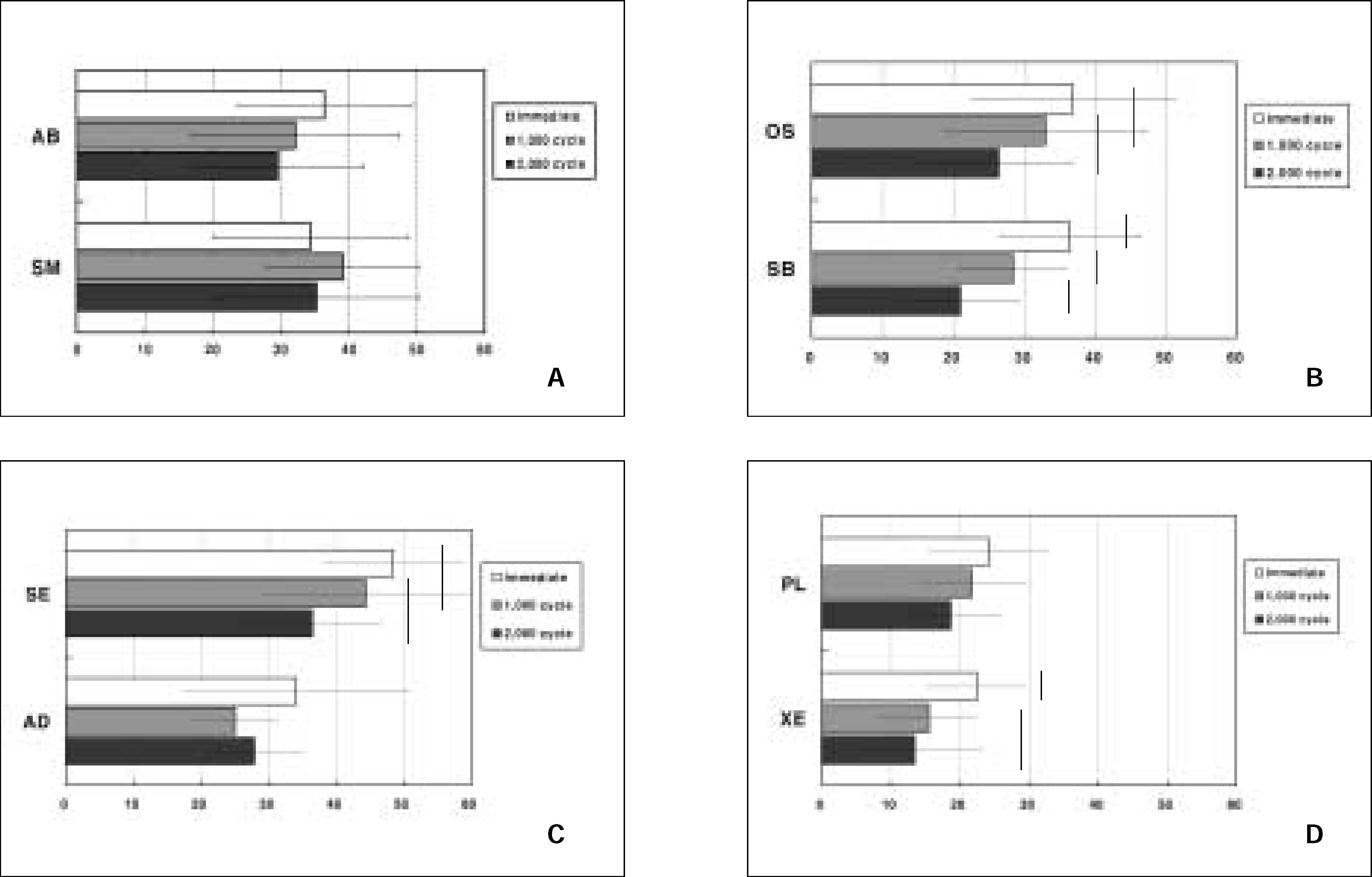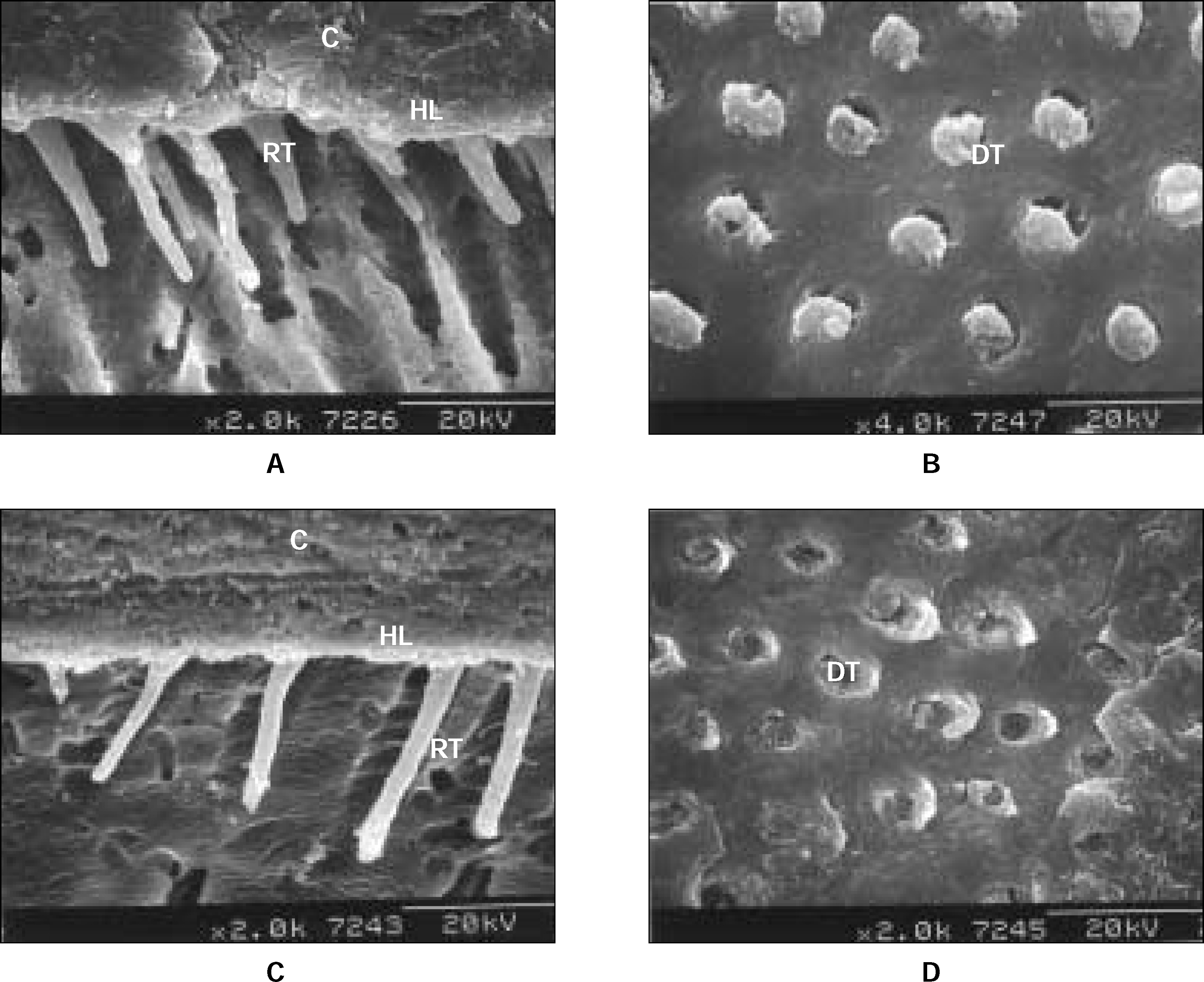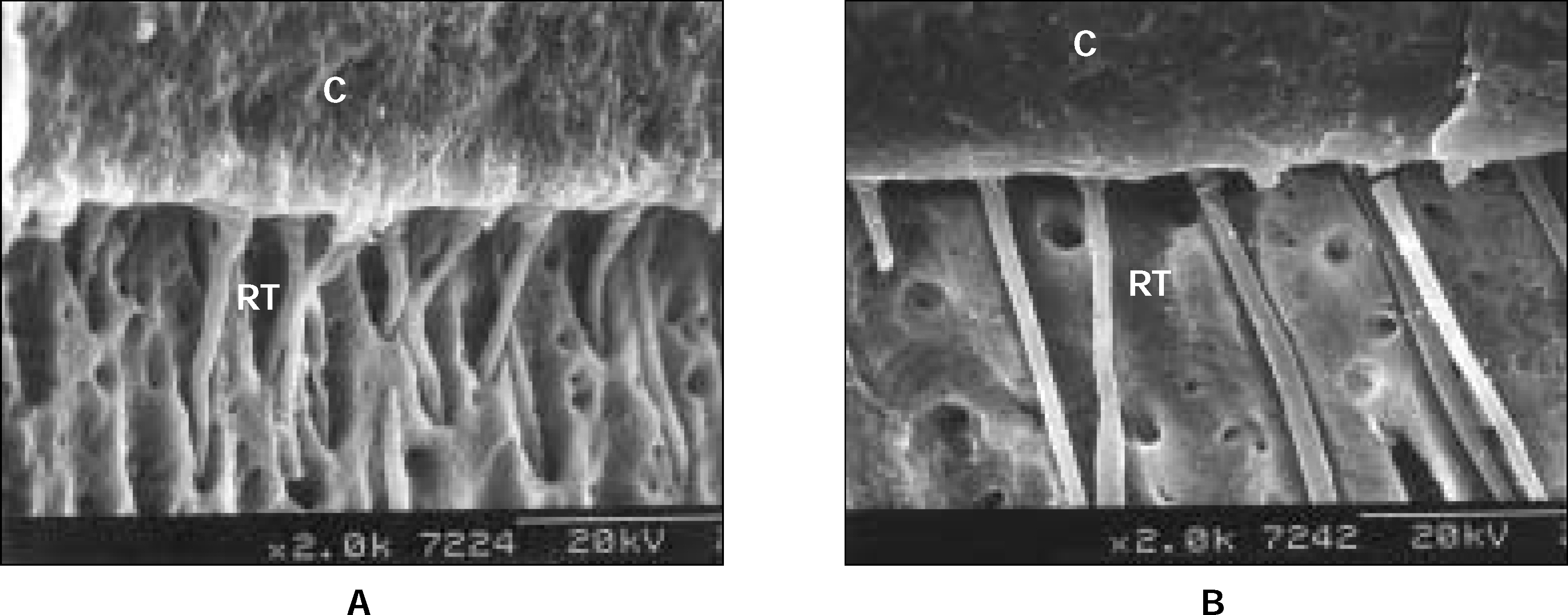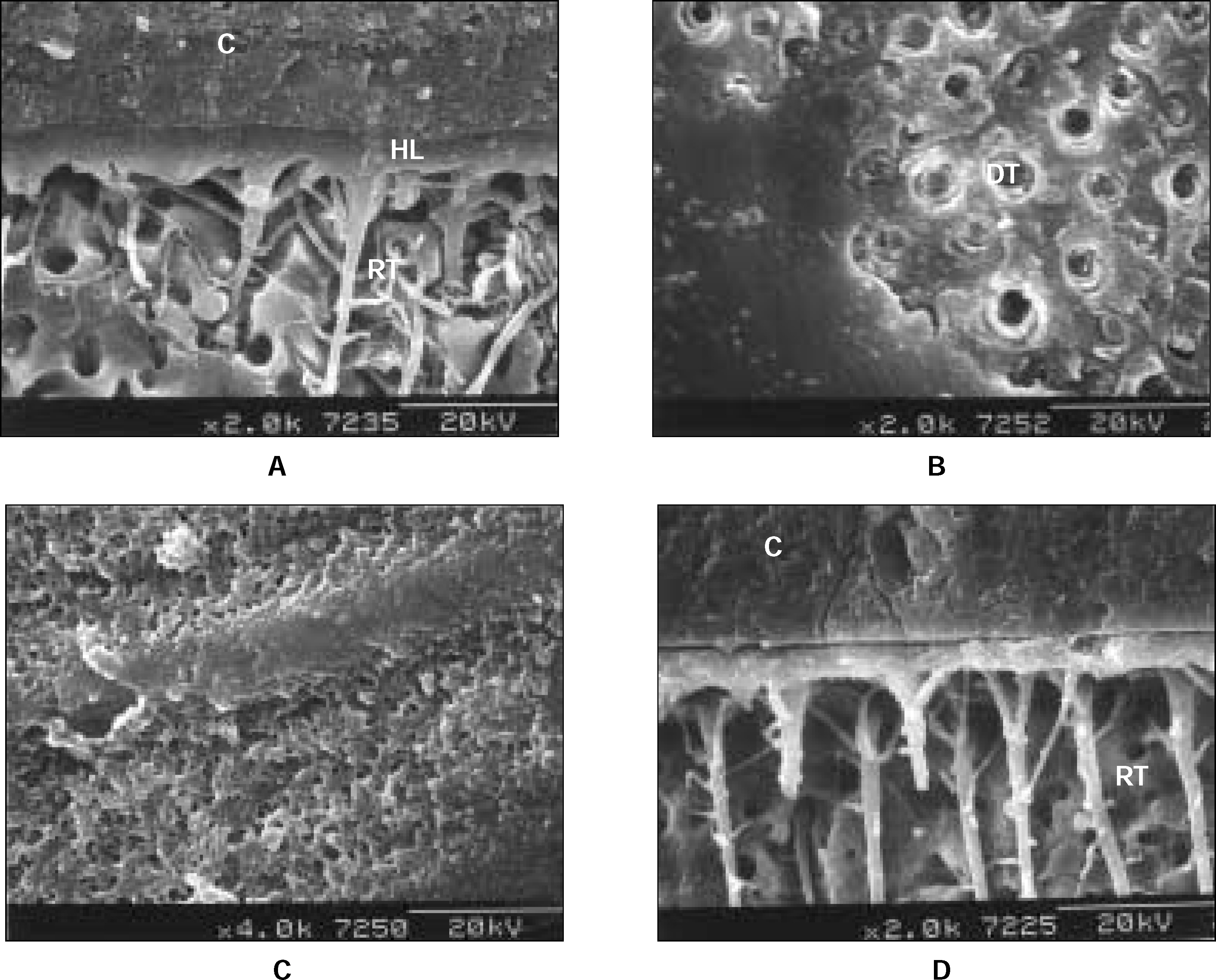J Korean Acad Conserv Dent.
2007 May;32(3):222-235. 10.5395/JKACD.2007.32.3.222.
The effect of thermocycling on the durability of dentin adhesive systems
- Affiliations
-
- 1Department of Conservative Dentistry, Division of Dentistry, Graduate of Kyung Hee University, Korea. psangjin@khu.ac.kr
- KMID: 2175875
- DOI: http://doi.org/10.5395/JKACD.2007.32.3.222
Abstract
- The objectives of this study was to evaluate the effect of thermocycling on the microTBS (microtensile bond strength) to dentin with four different adhesive systems to examine the bonding durability. Freshly extracted 3rd molar teeth were exposed occlusal dentin surfaces, and randomly distributed into 8 adhesive groups: 3-steps total-etching (Scotchbond Multi-Purpose Plus; SM, All Bond-2; AB), 2-steps total-etching (Single Bond; SB, One Step plus; OS), 2-steps self-etching (Clearfil SE Bond; SE, AdheSE; AD) and single-step self-etching systems (Promp L-Pop; PL, Xeno III; XE). Each adhesive system in 8 adhesives groups was applied on prepared dentin surface as an instruction and resin composite (Z250) was placed incrementally and light-cured. The bonded specimens were sectioned with low-speed diamond saw to obtain 1 x 1 mm sticks after 24 hours of storage at 37degrees C distilled water and proceeded thermocycling at the pre-determined cycles of 0, 1,000 and 2,000. The microTBS test was carried out with EZ-tester at 1 mm/min. The results of bond strength test were statistically analyzed using one-way ANOVA/Duncan's test at the alpha < 0.05 confidence level. Also, the fracture mode of debonded surface and the interface were examined under SEM. The results of this study were as follows; 1. 3-step total etching adhesives showed stable, but bond strength of 2-step adhesives were decreased as thermocycling stress. 2. SE showed the highest bond strength, but single step adhesives (PL, XE) had the lowest value both before and after thermocycling. 3. Most of adhesives showed adhesive failure. The total-etching systems were prone to adhesive failure and the single-step systems were mixed failure after thermocycling. Within limited results of this study, the bond strength of adhesive system was material specific and the bonding durability was affected by the bonding step/procedure of adhesive. Simplified bonding procedures do not necessarily imply improved bonding performance.
Keyword
Figure
Cited by 2 articles
-
Quantitative comparison of permeability in the adhesive interface of four adhesive systems
Juhea Chang, Keewook Yi, Hae-Young Kim, In Bog Lee, Byeong Hoon Cho, Ho-Hyun Son
J Korean Acad Conserv Dent. 2009;34(1):51-60. doi: 10.5395/JKACD.2009.34.1.051.Effect of Er:YAG lasing on the dentin bonding strength of two-step adhesives
Byeong-Choon Song, Young-Gon Cho, Myung-Seon Lee
J Korean Acad Conserv Dent. 2011;36(5):409-418. doi: 10.5395/JKACD.2011.36.5.409.
Reference
-
참고문헌
1. Raskin A, Mechotte-Theall B, Vreven J, Wilson NH. Clinical evaluation of a posterior composite 10-year report. J Dent. 27:130–19. 1999.
Article2. Wilder AD, May KN, Bayne SC, Taylor DF, Leinfelder KF. Seventeen year clinical study of ultraviolet-cured posterior composite class I and II restorations. J Esthetic Dent. 11:135–142. 1999.3. Sano H, Takatsu T, Ciucchi B, Horner JA, Matthews WG, Pashley DH. Nanoleakage: leakage within the hybrid layer. Oper Dent. 20:18–25. 1995.4. Yoshida Y, Van Meerbeeek B, Nakayama Y, Snauwaert J, Hellemans L, Lambrechts P, Vanherle G, Wakasa K. Evidence of chemical bonding at biomateri-al?hard tissue interfaces. J Dent Res. 79:709–714. 2000.
Article5. Primenta LAF, Amaral CM, Bredrane de Castro AKB, Ritter AV. Total-etch, deproteinization and self-etching. Oper Dent. 29:592–598. 2004.6. Paul SJ, Welter DA, Ghazi M, Pashley D. Nanoleakage at the dentin adhesive-interface vs. microtensile bond strength. Oper Dent. 24:181–188. 1999.7. Giannini M, Seixas CAM, Reis AF, Pimenta LAF. Six-month storage-time evaluation of one-bottle adhesive systems to dentin. J Esth Rest Dent. 15:43–49. 2003.
Article8. Tay FR, Pashley DH, Yoshiyama M. Two mondes of nanoleakage expression in single-step adhesives. J Dent Res. 81:472–476. 2002.9. Carracho AJL, Chappell RP, Glaros AG, Purk JH, Erick JD. The effect of storage and thermocycling of the shear bond strength of three dental adhesive. Quintessence Int. 22:745–752. 1991.10. Marshall GW, Marshall SJ, Kinney JH, Balooch M. The dentine substrate: structure-and properties related to bonding. J Dent. 25:441–458. 1997.11. Ferracane JL, Berge JR, Condon JR. In vitro aging of dental composites in-water-effect of conversion, filler volume, and filler/ matrix coupling. J Biomed-Mater Res. 42:465–472. 1998.12. Gale MS, Darvel BW. Thermal cycling procedures for laboratory testing of dental restorations. J Dent. 27:89–99. 1999.
Article13. Sano H, Yoshikawa T, Pereira PNR, Kanemura N, Morigami M, Tagami J, Pashley . Long-term Durability of dentine bonds made with a self-etching primer, in vivo. J Dent Res. 78:906–911. 1999.14. Tanumiharja M, Burrow MF, Tyas MJ. Microtensile bond strengths of seven-dentine adhesive systems. Dent Mater. 16:180–187. 2000.15. Burrow MF, Satoh M &, Tagami J. Dentin bond durability after three years using a dentin bonding agent with and with-out priming. Dent Mater. 12(5):302–307. 1996.
Article16. Li HP, Burrow MF, Tyas MJ. The effect of long-term storage on nano-leakage. Oper Dent. 26:609–616. 2001.17. Tay FR, Pashley DH, Suh BI, Carvalho RM, Itthagarun A. Single-step adhesives are permeable membranes. J Dent. 30:371–382. 2002.
Article18. Kanca 3rd J, Gwinnett AJ. Successful marginal adaptation of a dentin-enamel bonding system in vitro and vivo. J Esthet Dent. 6:286–94. 1994.19. Nakajima M, Kanemura N, Pereira PN, Tagami J, Pashley DH. Comparative microtensile bond strength and SEM analysis of bonding to wet and dentin. Am J Dent. 13:324–8. 2000.20. Reis A, Loguercio AD, Carvalho RM, Grande RH. Durability of resin dentin interfaces: effects of surface moisture and adhesive solvent component. Dent Mater. 20(7):669–76. 2004.
Article21. Reis A, Loguercio AD, Azevedo CLN, Carvalho RM, Siger JM, Grande RHM. Moisture spectrum of demineralized dentin for different solvent -based adhesive system. J Adhes Dent. 5:183–192. 2003.22. Takahashi A, Inoue S, Kawamoto C, Ominato R, Tanaka T, Sato Y, Pereira PNR, Sano H. In vivo longterm durability of the bond to dentin using two adhesive systems. J Adhes Dent. 4:151–159. 2002.23. Miyazaki M, Sato M, Onose H, Moore BK. Influence of thermal cycling on dentin bond strength of two-step bonding systems. Am J Dent. 11:118–122. 1998.24. Nikaido T, Kunzelman KH, Chen H, Ogata M, Harada N, Yamaguchi S, Cox CF, Hickel R, Tagami J. Evaluation of thermal cycling and mechanical loading on bond strength of a self-etching primer system to dentin. Dent Mater. 18:269–275. 2002.
Article25. Shirai K, De Munck J, Yoshida Y, Inoue S, Lambrechts P, Suzuki K, Shintani H, van Meerbeek B. Effect of cavity configuration and ageing on the bonding effectiveness of six adhesives to dentin. Dent Mater. 21:110–124. 2005.26. 조영 곤, 반일 환, 유미 경. 상아질 접착 후 저장기간에 따른 접착 제의 접착력의 변화. 대한치과보존학회지. 30(3):204–205. 2006.27. Kato G, Nakabayashi N. The durability of adhesion to phosphoric acid etched, wet dentine substrates. Dent Mater. 14:347–352. 1998.28. International Organization for Standardization. ISO TR 11405, Dental materials-guidance on testing of adhesion to tooth structure. 1994.29. Hashimoto M, Ohno H, Kaga M, Endo K, Sano H, Oguchi H. In vivo. degradation of resin-dentin bonds in humans over 1 to 3 years. J Dent Res. 79:1385–1391. 2000.30. Fumiaki K, Takafumi O, Tetsuo I, Naoyuki M. Influence of thermal cycles in water on flexural strength of laboratory-processed composite resin. J Oral Rehabil. 703–707. 2001.
Article31. Hakimeh S, Vaidyanathan J, Houpt ML, Vaidyanathan TK, Hagen SV. Microleakage of compomer class V restorations: effect of load cycling, thermal cycling, and cavity shape differences. J Prosthet Dent. 83:194–203. 2000.
Article32. Wendt SL, Mcinnes PM, Dickinson GL. The effect of therm- cycling in microleakage analysis. Dent Mater. 8:181–184. 1992.33. Krejci I, Lutz F. Mixed class V restorations: the potentials of dentine bonding agent. J Dent. 18:263–270. 1990.34. Nakajima M, Ogata M, Okuda M, Tagami J, Sano H, Pashley DH. Bonding to caries-affected dentin using self-etching primers. Am J Dent. 12:309–314. 1999.35. Tay FR, Pashley DH. Dental adhesives of the future. J Adhes Dent. 4:91–103. 2002.36. De Munck J, Van Landuyt K, Peumans M, Poitevin A, Lambrechts P, Braem M, Van Meerbeek B. A critical review of the durability of adhesion to tooth tissue: methods and results. J Dent Res. 84(2):118–32. 2005.
Article37. Frankenberger R, Strobel WO, Lohbauer U, Kramer N, Petschelt A. The effect of six years of water storage on resin composite bonding to human dentin. J Biomed Mater Res Part B: Appl Biomater. 69(1):25–32. 2004.
Article38. 장 영인, 최 경규, 박 상진. 복합레진에 대한 자가부식형 접착제의 적합성에 관한 연구. 대한치과보존학회지 31(in process). 2006.39. Armstrong SR, Vargas MA, Fang Q, Laffoon JE. Microtensile bond strength of a total-etch 3-step, total-etch 2-step, self-etch 2-step, and a self-etch 1-step dentin bonding system through 15-month water storage. J Adhes Dent. 5:47–56. 2003.40. Tay FR, Gwinnett JA, Wei SH. Relation between water content in acetone/alcohol-based primer and interfacial ultrastructure. J Dent. 26:147–156. 1998.
Article41. Choi KK, Condon JR, Ferracane JL. The effects of adhesive thickness on polymerization contraction stress of composite. J Dent Res. 79:812–817. 2000.
Article42. Yoshida Y, Nagakane K, Fukuda R, Nakayama Y, Okazaki M, Shintani H, Inoue S, Tagawa Y, Suzuki K, De Munck J, Van Meerbeek B. Comparative study on adhesive performance of functional monomers. J Dent Res. 83(6):454–8. 2004.
Article43. Burrow MF, Harada N, Kitasako Y, Nikaido T, Tagami J. Seven-year dentin bond strengths of a total-and self-etch system. Eur J Oral Sci. 113(3):265–70. 2005.44. Brackett MG, Dib A, Brackett WW, Estrada BE, Reyes AA. One-year clinical performance of a resin- modified glass ionomer and a resin composite restorative material in unprepared Class V restorations. Oper Dent. 27(2):112–6. 2002.45. Tu¨rku¨n SL. Clinical evaluation of a self-etching and a one-bottle adhesive system at two years. J Dent. 31:527–534. 2003.46. Hashimoto M, Ohno H, Sano H, Kaga M, Oguchi H. Degradation patterns of different adhesives and bonding procedures. J Biomed Mater Res Part B: Appl Biomater. 66(1):324–30. 2003.
Article47. Tay FR, King NM, Suh BI, Pashley DH. Effect of delayed activation of light-cured resin composites on bonding of all-in-one adhesives. J Adhes Dent. 3(3):207–25. 2001.48. El Zohairy AA, De Gee AJ, Hassan FM, Feilzer AJ. The effect of adhesives with various degrees of hydrophilicity on resin ceramic bond durability. Dent Mater. 20:778–787. 2004.49. Carrilho MR, Carvalho RM, Tay FR, Pashley DH. Effects of storage media on mechanical properties of adhesive systems. Am J Dent. 17(2):104–8. 2004.50. Yiu CK, King NM, Pashley DH, Suh BI, Carvalho RM, Carrilho MR, Tay FR. Effect of resin hydrophilicity and water storage on resin strength. Biomaterials. 25:5789–96. 2004.
Article51. Yiu CK, King NM, Carrilho MR, Sauro S, Rueggeberg FA, Prati C, Carvalho RM, Pashley DH, Tay FR. Effect of resin hydrophilicity and temperature on water sorption of dental adhesive resins. Biomaterials. 27(9):1695–703. 2006.
Article
- Full Text Links
- Actions
-
Cited
- CITED
-
- Close
- Share
- Similar articles
-
- A comparative study of shear bond strength of flowable resin associated with dentin adhesive systems with thermocycling effect
- The bonding durability of total etching adhesives on dentin
- Effect of chlorhexidine on microtensile bond strength of dentin bonding systems
- The bonding durability of resin cements
- Comparison of the elastic modulus among three dentin adhesives before and after thermocycling



